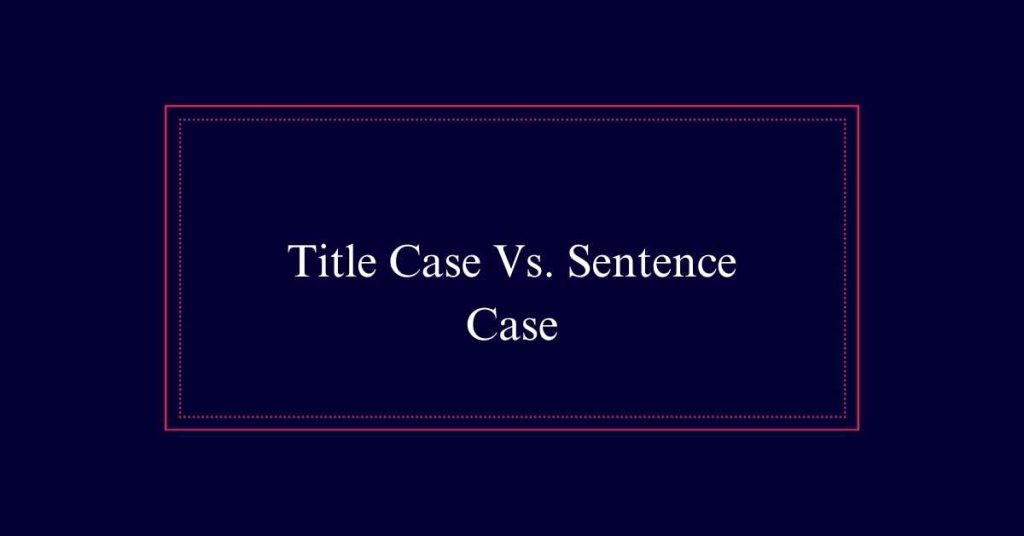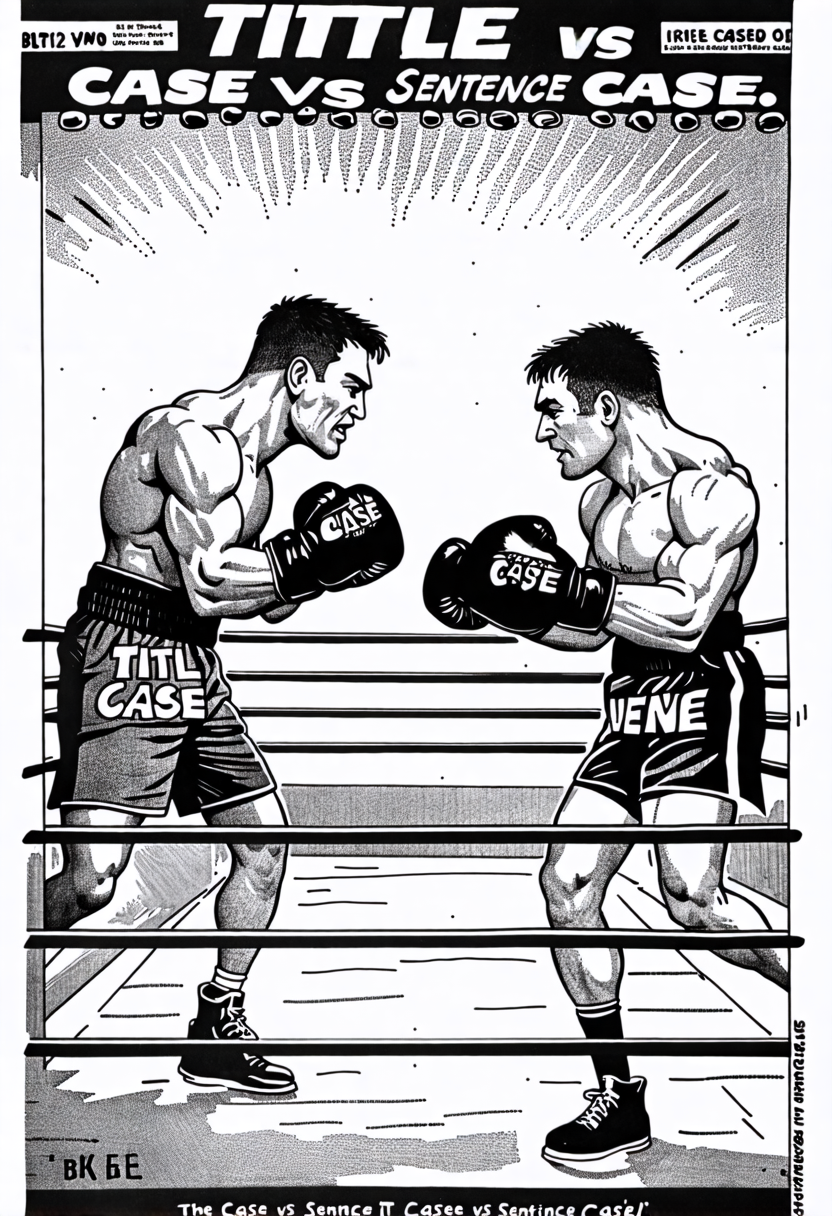Title Case Vs. Sentence Case
Title Case capitalizes the first letter of major words, including nouns, pronouns, verbs, adjectives, and adverbs. It’s commonly used in formal writing, such as academic papers, and follows specific style guides like MLA and Chicago.
Sentence case, on the other hand, capitalizes only the first word and proper nouns. It mimics standard prose, creating a more relaxed, informal tone often preferred for blog posts and social media.
Definition of Title Case
Title case is a capitalization style where the first letter of major words in a title is capitalized. This includes all nouns, pronouns, verbs, adjectives, adverbs, and some conjunctions. Minor words, such as articles, prepositions, and conjunctions with fewer than four letters, are typically not capitalized unless they are the first or last word in the title.
Title case is commonly used in formal writing, including academic papers and professional documents. It follows specific guidelines, such as those found in the MLA and Chicago style guides. For example, a title in title case might look like ‘The Mystery of the Missing Red Ruby.’ This style provides a clear, structured appearance, emphasizing the importance of each major word.
Definition of Sentence Case
In contrast to title case, sentence case capitalizes only the first word of a title and any proper nouns. This approach mimics traditional sentence structure, making it more aligned with standard prose writing.
Sentence case provides a more relaxed and informal tone, often used in casual writing contexts like blog posts or social media. For example, a headline might read, ‘The quick brown fox jumps over the lazy cat,’ with only the initial word and any proper names beginning with a capital letter.

While sentence case is less visually striking than title case, it is easier to read and understand. It is commonly used in AP style and is suitable for materials where a conversational tone is preferred.
Title Case in Formal Writing
Utilized extensively in academic papers and formal publications, title case guarantees that major words in headings and titles are capitalized to convey importance and structure. This method ensures clarity and hierarchy in written work.
Major style guides like MLA and Chicago endorse title case, making it a standard for scholarly articles and books. For example, in a dissertation or journal article, using title case in section headings lends an air of formality and respectability. Capitalizing the first word, all major words, and proper nouns enhances readability and emphasizes key elements.
Sentence Case in Casual Writing
Sentence case is commonly used in casual writing to create a relaxed and approachable tone. This style is often seen in blog posts, social media updates, and personal emails.
By only capitalizing the first word and proper nouns, sentence case mirrors natural speech patterns. This makes the content feel more personal and less formal. Additionally, it helps in keeping the writing accessible and easy to read.
For example, a blog post title like ‘How to make the perfect cup of coffee’ feels friendly and inviting. Using sentence case can enhance reader engagement by making the text appear more conversational. This approach is particularly effective in informal contexts where the aim is to connect with the audience on a personal level.
Style Guides and Case Usage
Style guides play an important role in determining whether to use title case or sentence case in various writing contexts. Different style guides have specific preferences.
For example, the MLA and Chicago Manual of Style recommend using title case for titles and headings. This creates a formal, professional appearance.
In contrast, the AP Stylebook suggests using sentence case for most titles and headings, which is often seen as more approachable and casual.
Rules for Title Case
Understanding the Rules for Title Case Helps Guarantee Consistency and Professionalism in Formal Writing
The first rule is to capitalize the first word of the title. All proper nouns should also be capitalized. Additionally, capitalize personal pronouns used as proper nouns. The word following a colon should be capitalized as well.
Minor words such as articles, conjunctions, and prepositions are generally not capitalized unless they are the first word of the title or follow a colon. Title case is commonly used in formal writing and is aligned with MLA and Chicago style guides. Proper application of these rules ensures clarity and uniformity in your titles and headings.
Rules for Sentence Case
Adhering to sentence case rules guarantees that only the first word and proper nouns are capitalized. This approach mirrors traditional prose writing and is often employed in more informal contexts. The rules for sentence case are straightforward: capitalize the first word of the title, any proper nouns, and the first word after a colon. Unlike title case, minor words such as conjunctions and prepositions remain in lower case.
| Rule | Example |
|---|---|
| First word capitalization | The quick brown fox… |
| Proper nouns capitalization | …in Dublin, Ireland. |
| Word after colon | …classics: exploring… |
Title Case Examples
While sentence case is prevalent in informal contexts, title case is often utilized in more formal writing and follows specific capitalization rules. Title case capitalizes the first letter of each major word, offering a sense of importance and structure.
For example, a book title might be ‘The Great Gatsby,’ while a chapter title could be ‘The Rise and Fall of Empires.’ Additionally, when using title case, proper nouns, personal pronouns, and the first word after a colon are always capitalized.
This style is commonly adopted in academic writing and formal documents, adhering to MLA and Chicago style guides. Examples include ‘Exploring the Wonders of the Universe’ and ‘Understanding Human Behavior: A Thorough Guide.’
Sentence Case Examples
Sentence case provides a straightforward approach to capitalization, making it ideal for casual and informal writing contexts. This style capitalizes only the first word of a sentence and any proper nouns.
For example, ‘The quick brown fox jumps over the lazy cat’ illustrates sentence case by starting with a capitalized ‘The’ and lowercase for the rest. Another example is ‘Science fiction classics: Exploring the timeless tales,’ where ‘Science’ is capitalized because it is the first word, and ‘Exploring’ after the colon.
Similarly, ‘Nadyas adventures living in Dublin, Ireland’ uses lowercase for all words except the proper nouns ‘Nadyas’ and ‘Dublin, Ireland’. These examples highlight the simplicity and readability of sentence case.
Choosing the Right Case
Choosing the appropriate case for your title can greatly impact the tone and clarity of your writing. Title case is ideal for formal contexts like academic papers or professional reports. It emphasizes the importance of each major word, giving a polished and structured appearance.
On the other hand, sentence case is better suited for informal or casual writing, such as blog posts or social media content. It mirrors natural sentence flow, making the text approachable and easy to read.
When deciding, consider your audience and the style guide you are following. MLA and Chicago styles favor title case, while AP style recommends sentence case. The right choice will enhance readability and set the desired tone.
Frequently Asked Questions
How Does Title Case Impact Readability Compared to Sentence Case?
Title case can enhance readability by emphasizing key words, making titles more noticeable. Sentence case, reflecting natural prose, offers a more relaxed and approachable style, potentially increasing ease of reading in casual contexts.
Can Title Case Be Used in Social Media Posts?
Yes, title case can be used in social media posts. It provides emphasis and can make content stand out. However, it is more formal, so consider the audience and platform when deciding between title case and sentence case.
Are There Any Exceptions to Capitalizing Minor Words in Title Case?
Yes, there are exceptions. In title case, minor words are capitalized if they are the first or last word of the title or follow a colon. For example, “The Benefits of Exercise: Why It Matters.”







